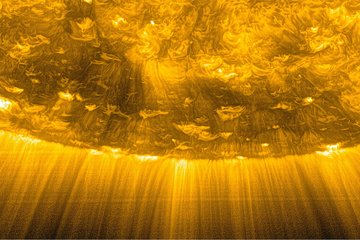All genres
41.
Journal Article
Minimum requirements for a solar probe mission. Advances in Space Research 17, pp. (3)85 - (3)90 (1996)
42.
Journal Article
Minimum requirements for a solar probe mission. Advances in Space Research 17, pp. (3)85 - (3)90 (1996)
43.
Journal Article
Implications of observations of the solar wind and corona for solar wind models. Astrophysics and Space Science 243, pp. 1 - 3 (1996)
44.
Journal Article
Fast ionospheric response to enhanced activity in geospace: Ion feeding of the inner magnetotail. Journal Geophysical Research 101, pp. 5047 - 5065 (1996)
45.
Journal Article
Auroral ionospheric ion feeding of the inner plasma sheet during substorms. J. Geomag. Geoelectr. 48, pp. 729 - 739 (1996)
46.
Journal Article
Konstantin Gringauz 1918-1993. Advances in Space Research 16, pp. (4)5 - (4)7 (1995)
47.
Journal Article
CELIAS-Charge, element and isotope analysis system for SOHO. Solar Physics 162, pp. 441 - 481 (1995)
48.
Journal Article
Quantum-limited synchrotron radiation in inhomogeneous magnetic fields. Astrophysical Journal 447, pp. 302 - 304 (1995)
49.
Journal Article
Acceleration of the high speed solar wind. Astronomy and Astrophysics 303, pp. L45 - L48 (1995)
50.
Journal Article
The ``Long Wavelength Radar'' on the Mars-94 Orbiter. Advances in Space Research 15, pp. (4)163 - (4)178 (1995)
51.
Journal Article
The good old days. Journal Geophysical Research 99 (A10), pp. 19199 - 19212 (1994)
52.
Journal Article
The origins of high-energy cosmic rays. Astrophysical Journal, Suppl. Ser. 90, pp. 937 - 944 (1994)
53.
Journal Article
Similarity solutions for synchrotron emission from a supernova blast wave. Astronomy and Astrophysics 291, pp. 935 - 942 (1994)
54.
Journal Article
The electromagnetic effects of the solar wind interaction with Phobos. Advances in Space Research 13, pp. (10)295 - (10)298 (1993)
55.
Journal Article
Synchrotron radiation: An inverse Compton effect. Astrophysical Journal 416, pp. 700 - 706 (1993)
56.
Journal Article
The electromagnetic effects of the solar wind interaction with the Phobos neutral gas halo and dust torus. Planetary and Space Science 40, pp. 1033 - 1041 (1992)
57.
Journal Article
Steady merging with recombination. Annales Geophysicae 10, pp. 827 - 834 (1992)
58.
Journal Article
A commentary on our present understanding of the Martian magnetosphere. Planetary and Space Science 39, pp. 167 - 173 (1991)
59.
Journal Article
On the first ionization potential effect of the solar corona. Advances in Space Research 11, pp. (1)247 - (1)250 (1991)
60.
Journal Article
Stability of a cometary ionosphere/ionopause including pressure effects. Astrophysical Journal 360, pp. 275 - 278 (1990)











